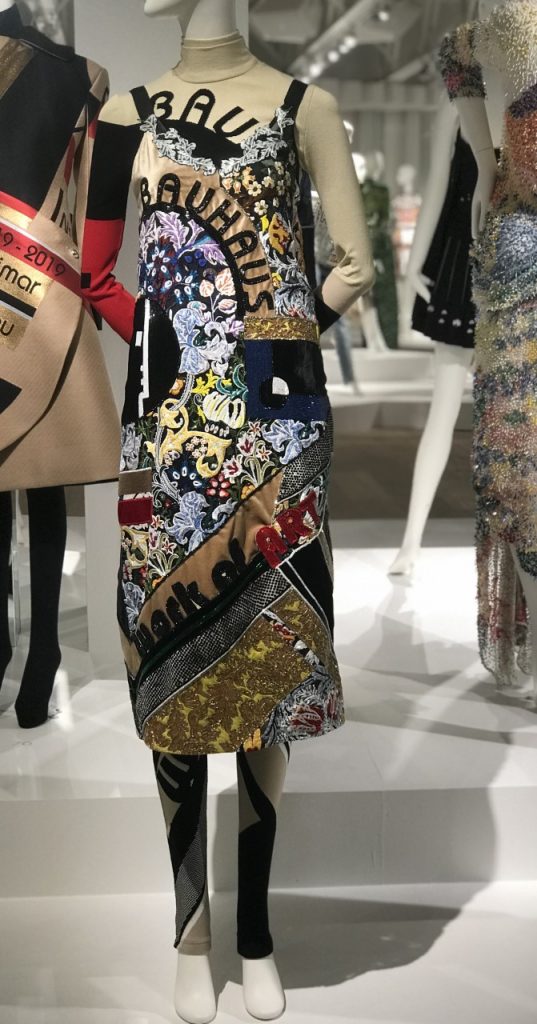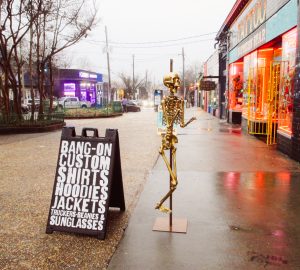The One Look Series is a four-part series that highlights writing pieces from the Fashion Journalism course. Students were asked to write a piece based off of one selected look from SCAD FASH Museum of Fashion + Film‘s current exhibition, “Kaleidoscope Katrantzou: Mary Katrantzou, 10 Years in Fashion.”
“Mixing Moderns” by Rose Andrews
Revered for her digital prints and bold silhouettes, Mary Katrantzou has made quite a name for herself at 36. She has won the Swiss Textiles Award in 2010 for her trompe l’oeil prints and has collaborated with globally recognized brands such as Adidas Originals and Victoria’s Secret.
The SCAD FASH Museum of Fashion + Film opened a retrospective exhibition honoring the London-based designer in April, “Kaleidoscope Katrantzou: Mary Katrantzou, 10 Years in Fashion.” It takes the viewers on a journey through her work as though they are following her career timeline.
The bright, mirrored space filled with her colorful patterned designs is kaleidoscopic, leaving no question as to how the exhibition earned its name.
Katrantzou’s Autumn/Winter 2018 Collection, “Interior Lives,” found inspiration in the paradoxical combination of functional Bauhaus modernism and the femininity of the Victorian era. “The collection explores an intermingling of two different breeds of aesthetic, using their components to discover a new hybrid,” according to Katrantzou’s website. Her research uncovered their potential compatibility.
“The roots of modernism lie, conversely, in the Victorian age, when practitioners such as William Morris began to approach aesthetics with an all-encompassing ideology that the Bauhaus would dub gesamtkunstwerk–a total work of art,” her website continues.
“Here, all arts, fine and applied, would eventually be brought together.” Thus, the season marries fine arts with applied arts.
Thanks to her background in creating textiles for interiors, Katrantzou considers fashion design and the decorative arts as a whole, rather than relying simply on clothing for inspiration.
The designer has shared many of her influences such as the Bauhaus furniture that heavily informed the lines, geometric shapes and silhouettes found in the looks. The Bauhaus posters that inspired the collection encouraged her use of graphic art.
Victorian-era drapery and lampshades are reflected in the collection through trompe l’oeil, sequined drapery and structured garments. Elements such as embroideries, tapestries and fabric manipulations highlight the importance of craft and technique rooted in both eras.
Katrantzou implemented these through knits inspired by Bauhaus lines, sequins and tapestries informed by 19th century Persian rugs, the linear silhouette of the Twenties and the hourglass figure of the 1900s. This collection is full of nods to the most important elements of the Bauhaus movement and Victoriana.
Though many of the designs seemingly lean toward one era, Katrantzou used her skills to implement aspects of each across the entire collection. In Look 69, the mannequin is adorned in the “Treib Jumpsuit” with the velvet “Oskar Dress” draped over top.

This ensemble immediately draws the eyes to the bold Bauhaus graphic on the front of the dress — below yet another Bauhaus graphic on the jumpsuit.
The velvet dress, ornately decorated with embroidered, sequined and beaded panels, brings Victorian-era drapery back to life by encapsulating the spirit of Bauhaus and Victoriana.
Each closer observation reveals a new and unique detail. This is a recurring theme throughout the exhibition; such is the minute attention given to her work. The contrast between the two styles is evident, but Katrantzou’s deep knowledge of the eras, paired with her creativity, allowed her to mold them together.
In an interview with Dezeen, Katrantzou said, “I don’t think anyone would put the arts and crafts movement and the Bauhaus together conceptually, but I think it was the beginning of modernism, even if aesthetically it is not as visible.”




















